Cuba’s Jardines de la Reina
Just 500 divers each year get to see the Caribbean as it was 60 years ago.
Text by Joseph Frey
Photos: Courtesy Avalon Diving Centres
Rolling off the skiff for the last dive of the week I barely miss three Caribbean reef sharks in the shallows. Startled, they quickly scatter then regroup and drift to the reef below. As if in a slipstream I descend the 30 feet (10m) with them to a reef that boasts the healthiest coral in the Caribbean. The flora and fauna is bursting with colour and all around the waters are teaming with tropical fish. This pristine ecosystem has changed little since Christopher Columbus first spotted the islands and reefs of what are now called Cuba’s Jardines de la Reina or Queen’s Gardens.
These reefs located in the Gulf of Ana Maria 60 miles (100km) south of Cuba’s central provinces of Ciego de Avila and Camaguey are for the most part inside the Jardines de la Reina National Park, which is accessed from the sleepy fishing village of Jucaro.
Changing Times
I began scuba diving in the Caribbean in 1971 and since then 80 per cent of the region’s coral reefs have been severely degraded or have died off due to climate change and human stressors. Stronger hurricanes brought about by climate change can inflict severe damage on coral reefs. More lethal than hurricanes is bleaching, when corals expel algae, turn white and often die, due to warming seawater.
If bleaching is the only factor stressing a coral reef it has a 70 per cent chance of recovery. The odds drop when you add in human stressors that in the Caribbean include mass tourism, hotel development, too much scuba diving in popular areas, the introduction of invasive marine species, overfishing, removal of coastal mangroves, coastal deforestation, chemical fertilizer runoff and animal waste from farming activities. Fortunately these are largely absent from Cuba’s southern coast. Combine this with sound public policy that created national marine parks here in 1996, and the Jardines de la Reina flourishes today.
We arrive in Jucaro after a six-hour bus ride from Havana. Inside a fenced compound we see half a dozen live-aboard yachts operated by Avalon, an Italian company that also provides logistical support to its floating hotel, the Tortuga, from this shore base. Through its contract with the Cuban government Avalon is the only firm permitted to take divers and catch and release anglers to the Jardines de la Reina. Just 500 divers and 500 anglers (recently reduced from 1,000) are permitted into the Jardines de la Reina National Park each year.
Fortunate Few
We’re among the fortunate 500 scuba divers who get to dive three times a day and experience a little of the Jardines de la Reina’s many reefs and mangrove islands spread across the 675 square miles (1,750 km) of Cuba’s coastal seas that Avalon manages. On this occasion I’m among seven guests from Spain, Italy and Canada, and a crew of four, aboard La Reina.
My fellow scuba divers are intelligent, amusing and great travel companions. Javier Sr. and Javi Jr. are father and son; both are dentists from Balboa, Spain. Javier is quite intense, has a keen knowledge of Spanish naval history and has brought novels along written by Cuban writers. He and I communicate with each other using our limited high school French, with the odd German, English and Spanish words thrown into the conversations. Javi has just completed his master’s degree in orthodontics, and speaks English.
Adriano (Adri) and Chiara live on an estate near Milan, Italy. Adriano owns a company that paves highways and is a Formula One enthusiast while Chiara works in hospital risk management and is an equestrian. Both are chatty and full of laughter the entire week. I’ve never seen such a loving couple. Adri speaks Italian only while Chiara speaks some English and a bit of German. Even with a language barrier Adri and I communicate through hand gestures, we find the same things funny and we both love beer and food.
There are two other Canadians, fellow Torontonians. Curtis is a financial investor, and his wife Christine is a medical doctor specializing in hematology. It turns out Christine and I share Hungarian heritage and soon we’re swapping tales of our parents and their escapes from communist Hungary, ironic considering we’re in Cuba.
During the six-hour sail from Jucaro to the Jardines de la Reina we get to know La Reina’s crew. The yacht’s captain Guillermo (Guilli) is from Italy. Jensy the yacht’s engineer is Latino-Cuban. Through years of hard work Jensy has worked his way up to an engineering position from being a deckhand. He is self-taught in English and has a great sense of humour. Joseph, our benevolent Afro-Cuban cook whipped up great meals with a heavy emphasis on fresh fish for lunch and dinner. He engages in intense discussions with Javier over Cuban literature. Ramon, a Latino-Cuban with Asiatic features, is the strong and quiet skiff driver for our forthcoming dives. Fausto is our dive master, with Gustavo (Tavo) a Latino-Cuban who is our secondary dive master.
Aquatic Mélange
The next morning our dive skiff heads for Anclitas, a site of coral reefs remarkable for their layers of texture and structural complexity. In 50 to 60 feet (15-18m) at this one site we see spiny lobsters, green morays, southern stingrays, a large green turtle, black groupers, Nassau groupers and lionfish!
Before our second dive of the morning we go ashore on a small island inhabited by feral rats called ‘jutia’ (hoot-ee-ya). These rather entertaining beaver-like rodents approach us without fear and are easy to photograph. Quite likely they were introduced by the Spanish and have evolved in isolation, or at least with the other wildlife that includes iguanas that are about half their size.
The next dive is at a place called Pipin, our first big shark encounter, in about 80 feet (24m). Here, a dozen Caribbean reef and silky sharks swim all around us and while they are fascinating, the icing on the cake is to watch the interplay between them and the local Goliath groupers, themselves big fish and, as we quickly come to understand most capable in the face of all other reef inhabitants and casual visitors infringing on their ‘turf’. It’s an exhilarating dive.
Lunch and a siesta follow aboard La Reina. Mid afternoon we’re off again, this time to Boca de Piedras for more sharks, including Caribbean reef sharks and their retinue of free ride remoras, and a nurse shark under a coral overhang. Pilot fish are present of course and, as ever move in perfect unison with the sharks. A comical moray, a huge barracuda, a green turtle, black groupers, a solitary lionfish and a scatter of pulsating moon jellies are also on hand to animate the site, which certainly has its share of top predators. Barrel sponges here are impressive and the sheet coral too; all this in just 60 to 70 feet (18-21m). It was a remarkable first day of diving and indicative of what we would see throughout the week.
Heading back, our skiff skims through the beautiful mangrove islands of the Jardines. The combination of strict conservation and minimal human activity along the southern coasts of Ciego de Avila and Camaguey provinces ensures coastal mangroves and wetlands remain intact, which in turn contributes to what is the most mature food web in the Caribbean. It’s similar to the best-preserved food webs of the Indo-Pacific region of eastern Indonesia, which accounts for the large number of top predators here, including sharks, snappers and groupers.
People, Pork Test
Depending on the time of year and your location in the Jardines you’ll be able to see many different shark species, among them Whale sharks, spinners, lemons, Caribbean sharpnose sharks, Great hammerheads, Blacktips, Tigers, Caribbean reef sharks, Silky sharks and Nurse sharks. We see the latter three on a daily basis. You just don’t get these shark sightings in other parts of the Caribbean anymore.
It’s impressive and as I mentioned before it’s a treat observing the territorial behaviour of 200-pound (90kg) plus Goliath groupers and 100-pound (45kg) Black groupers facing off all comers, ourselves included, if we get a little close for their comfort. These guys are very protective, unlike the sharks, even the big ones at 10 feet (3m) plus, which are unwilling to engage over territorial rights. Sharks are lazy hunters while groupers are clever and patient and put more effort into hunting down their next meal.
Some of the dive masters decide to see just what attracts sharks so they fill two baskets, one with frozen fish blood and parts and another with frozen pig’s blood, guts, ribs and limbs. Anatomically, pigs are very similar to humans, hence some of their organs are transplanted into humans, and their blood is very similar to ours as well. In the water the sharks circle the fish basket and then tear it apart for the fish. They ignore the pork.
In a further experiment dive masters hold pieces of pig in front of the sharks’ snouts. Again this bait is ignored, suggesting that humans have little to fear from sharks even when bleeding in the water. This seems especially so in the healthy biomass of the Jardines where a shark’s next meal is always close at hand, or mouth.
On one dive I drift slowly along a reef watching a shark as it spots a clump of seaweed just below the surface. It quickly closes in to investigate then swims off. Sharks are abundant in the Jardines and after just a few days we’re at ease with them swimming very close by. On another occasion a Caribbean reef shark won’t leave my side for a long while, moving where I move; it’s reminiscent of an experience I had in a four-plane strike formation of CF-18 fighter jets. Like the planes around me, this shark was a wingman maintaining distance and pace with precision.
Conservation Working
Funding for research that’s led to establishment of marine reserves in Cuba came from organizations such as the World Wildlife Federation – Canada, and the Canadian International Development Agency (CIDA) in the 1980s. Since 1996 the Cuban government has been funding scientific research in the Jardines, now overseen by Dr. Fabian Pina of the Coastal Ecosystems and Marine Research Centre of Cuba, in Ciego de Avila, the capital of the province that takes the same name. Assisting with research in the Jardines is the marine sciences department of the University of Havana (CIM-UH) under the directorship of Dr. Jorge Angulo, educated at the University of Havana and at Canada’s Dalhousie University in Halifax, Nova Scotia.
Since 1996 fish stocks have increased by 30 per cent within the Jardines de la Reina National Park, resulting in a 20 per cent increase in fish populations outside park boundaries for the local commercial fishing industry. The only commercial take permitted in the Jardines is for Caribbean Spiny lobster, a sustainable population throughout Cuba’s coastal waters. Otherwise, commercial fishing is prohibited and enforced by fisheries patrols. You’ll find species of fish here that have disappeared elsewhere in the Caribbean.
The Jardines are home to numerous vulnerable and endangered species. Six of the 10 species of sharks found in the Jardines are listed as vulnerable in other parts of the Caribbean. The national park is also home to other endangered forms of life such as plants, birds, iguanas and marine mammals, Loggerhead turtles, Green turtles, Hawksbill turtles, Queen Conchs (molluscs), American crocodiles, Black coral and extremely sensitive Staghorn and Elkhorn corals. Elkhorn coral is the canary in the coalmine on a coral reef; when it starts to die, as it has in many parts of the Caribbean, it’s a warning the reef’s in decline. In the Jardines you see only healthy Elkhorn. Amazing to me because of its absence in recent decades. Also recalling my Caribbean diving experiences of the 1970s, is the abundance here of live Queen conch, in just 30 or so feet (10m). Usually, they’re quickly scooped up and eaten by locals or cooked in restaurants for tourists.
Overall health of the Jardines ecosystem allows it to thrive and recover quickly when stressed. The Jardines has survived Soviet-era chemical fertilizers, and the Long-spined urchin is making a comeback following a die-off in the 1980s. Today, Cuban agriculture is organic, and sound public policy based on scientific research works hand in hand with strict conservation laws that protect the Jardines de la Reina. And now the fortunate 500 divers each year get to experience a little time travel and see a Caribbean of 60 years ago.
10 Responses to “Cuba’s Jardines de la Reina”
Leave a Comment

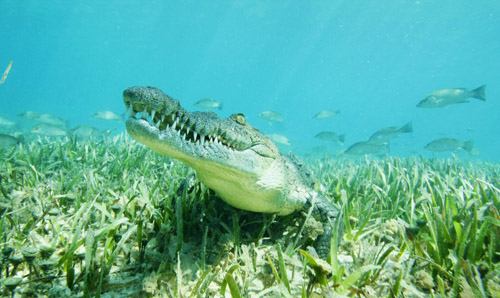
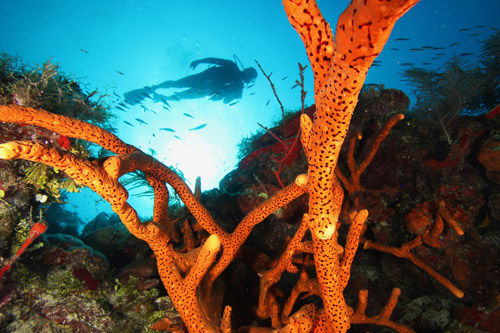
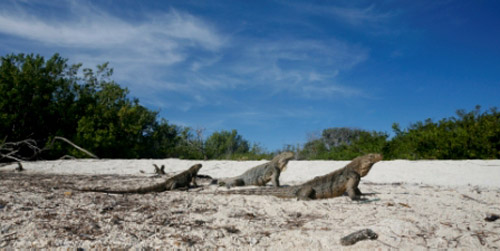
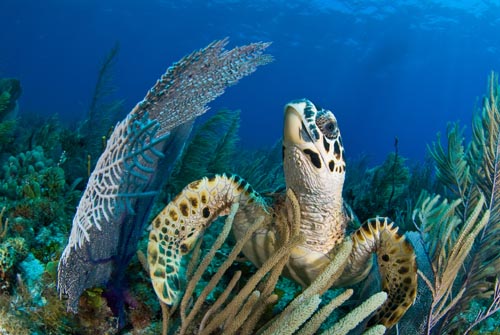
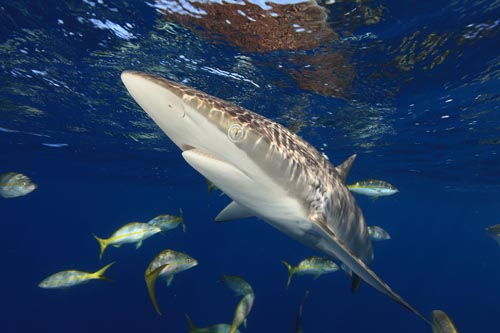
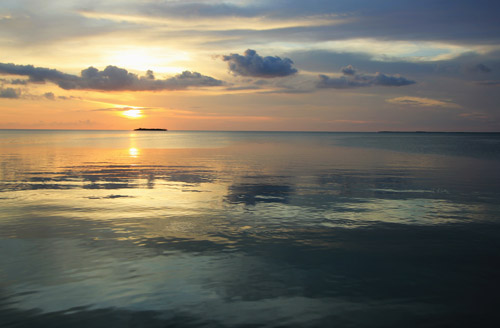







Richard Wiese
The style of writing made me feel that i was on a really great expedition. After reading this article it made me want to dust off my padi card and get back into the water. Wonderful
George Burden
Well written piece on an unfortunately rare preserve of undamaged coral reef. Excellent article Mr. Frey!
Lorie Karnath
A wonderful article about a very special area off Cuba’s shores. It show what is possible when proper precautions towards the preservation are taken. It is clear that Joseph Frey as a writer/diver has a profound respect for the region. Thanks for the piece as well as the beautiful photos.
Richard Langlois
This is a very noteworthy article! As a regular Diver Magazine reader, I am used to articles describing ones experience and telling us what we must see in a specific location. This article, while very inviting in that respect, also compels us to rethink how we see our favourite hobby.
We, divers, tend to take for granted that every part of the undersea is accessible to us while governments and industries are the source of the decline of reefs. While a lack of interest or willingness from these players does impact the reef negatively, we too have a part to play in the decline of reefs. Our greed for easy access to dive sites and nearby amenities drives the industry and the involvement from governments who see dive sites as a lucrative tourist attraction.
How many of us would be willing to support a limit on divers in the Florida Keys or on the North-American West Coast? Very few I suspect, even though we all know that it would be the most significant step towards creating a lasting partnership with governments and industries and the rebuilding of local reefs.
While I appreciate this article does not suggest such a step be taken, it makes me wonder if we, as divers, are really doing enough to demonstrate our resolve in protecting the fragile underwater ecosystem? Maybe someday there will be enough sites such as this one that we will not have to pray for a shark encounter at our favourite travel destination. Thank you to the author and to Diver Magazine for this enlightening article.
Anne Doubilet
Joe Frey’s descriptions and history of the area provide an excellent background for one of the last existing Caribbean paradise dive spots. His article makes me want to go there now more than ever. And lucky him to be one of only 500! It’s a double-edged sword nowadays to publicize a pristine place but his thoughtful text makes it clear how well managed the area is. Kudos, Joe!
Peter Rowe
Great article. This man can write. There are several interesting features of the article that make it stand out above the usual dive magazine destination piece. First, the intriguing descriptions of his dive companions on the trip. Almost half the interest of a remote dive expedition is the mix of other divers one meets on it, but it is rare that dive writers explore this. Joe’s descriptions of his multinational and cosmopolitan dive companions made for fascinating reading. Equally interesting were his descriptions of the interplay between the groupers and sharks, and the tests done to gauge the appetite of the sharks for pork. Somewhat reassuring news for people nervous about swimming in what used to be called “shark-infested” waters.
Like the author, I’ve been bummed out by the degradation of Caribbean reefs in our lifetime. It is great to read a place where the reefs and marine life seem to be as healthy as they were 30 years ago.
Brian Helmuth
What a fantastic article, and such a great reminder of what conservation can accomplish. While it is depressing to think that the rare sites that Mr. Frey describes were at one time commonplace in the Caribbean, it does provide hope that we may be able to preserve some of these gems if we can manage to get our act together as a species.
Walter M
An outstanding article! Clear, articulate – it made you feel as though you’re right there! I’ve never had the privilege of diving in Cuba, but it’s clear that anyone who hasn’t has certainly been missing out. I have long used this resource to find answers to my diving questions/needs, and this article is yet another example of how professional and thorough a resource you’ve become. Thank you (and the author) for helping me plan my next diving excursion.
Nigel Haines
Excellent article! It takes me back to 1981 when, as a member of the first organised group from the U.K., I dived Cuba’s Isle of Youth while the Soviets were still there. Having dived the Bahamas, Caymans, Barbados and the Florida Keys, including the Dry Tortugas and Fort Jefferson since that time, I fondly recall the richness of the marine life found in Cuban waters compared to the rest of the Caribbean.
Having spent the last 35 years diving in the Indian Ocean, South China Sea and the Pacific, I really must go back to Cuba before hordes of American divers flood the country as a result of President Obama’s long overdue relaxation of sanctions!
Kris Kurtossy
Great article, thank you for promoting this beautiful dive spot, that yes is still well protected & cherished! I have been arranging dive & fishing trips for the past 20 years to this special region, with stops also in Havana & Trinidad de Cuba, pre & post diving for a few days, to also enjoy Cuba’s eclectic, fabulous culture, history & architecture! If you would like to plan a private or group trip, designed personally for your interests, by an experienced, licensed Travel Consultant & Cuba Trip Specialist who knows her stuff (as a client & top CEO stated) & she has interesting history stories too… because she actually lives here… I’m your woman in Havana!